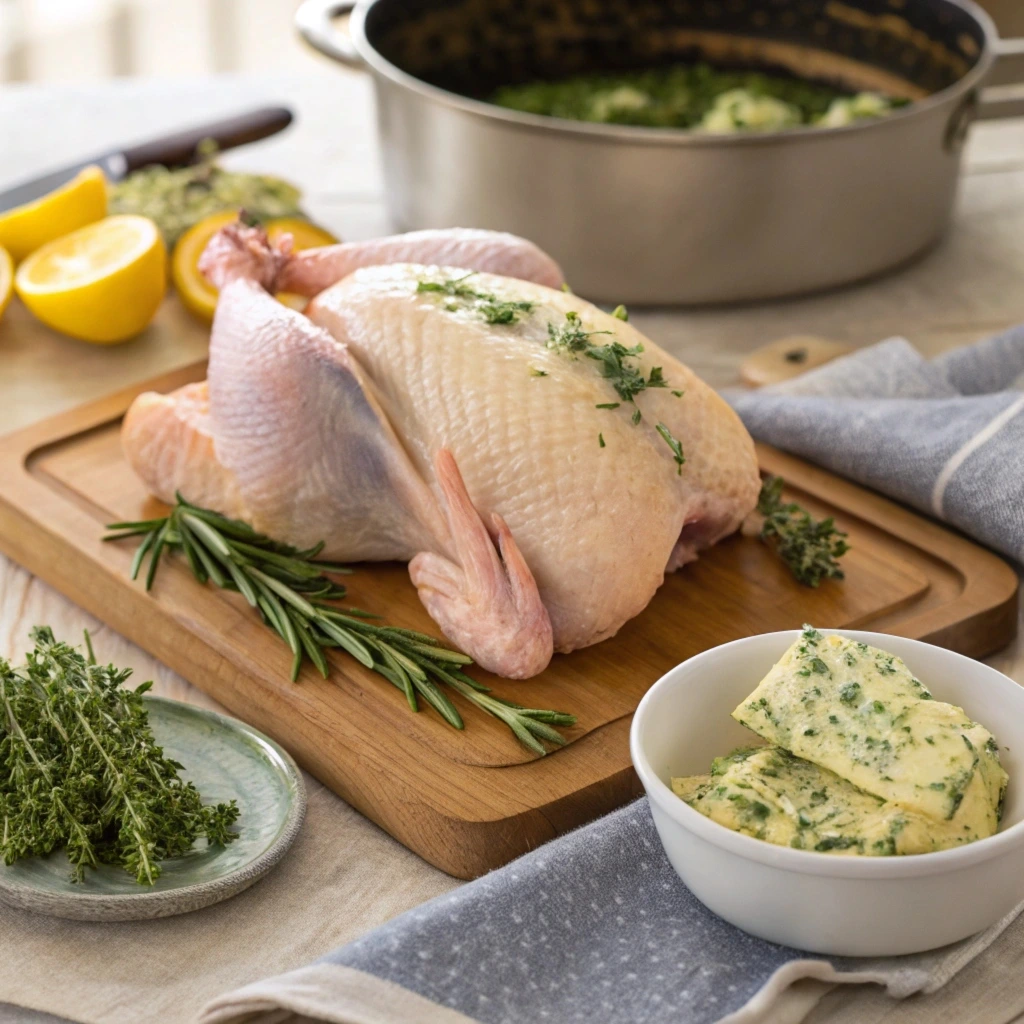Cooking the perfect turkey can feel like a balancing act. You want it juicy on the inside, golden on the outside, and full of flavor in every bite. One of the most talked-about techniques is putting butter under the skin of the turkey. This method might sound fancy, but it’s a tried-and-true way to take your bird from good to unforgettable.
In this article, we’ll explore why buttering under the skin works so well, the science behind it, and how you can do it step by step. Along the way, we’ll debunk myths, answer frequently asked questions, and give you the tools to create a turkey that’s crispy, juicy, and downright delicious.
Introduction to Buttering Under the Skin
What It Means to Butter Under the Skin
Putting butter under the skin of a turkey involves gently loosening the skin from the meat and spreading a layer of seasoned butter directly onto the flesh. This technique helps the butter melt during cooking, infusing the meat with moisture and flavor from the inside out.
Unlike slathering butter on the surface, which can drip off or burn, butter under the skin stays locked in place, working its magic throughout the roasting process. It’s a simple trick that elevates any turkey—whether you’re making a Thanksgiving centerpiece or just a family dinner.
A Brief History of the Technique
The idea of adding fat for flavor isn’t new. Chefs and home cooks have long used fats like butter, lard, or oil to improve the texture and taste of meat. However, the practice of placing butter under the skin gained popularity in recent decades as cooks sought ways to make turkey juicier without brining or lengthy marinades.
This technique has since become a staple in kitchens everywhere, especially during the holidays.
Why It’s Popular for Thanksgiving and Holiday Meals
Thanksgiving and other festive occasions often feature turkey as the star of the meal. With so much riding on this dish, it’s no wonder people want foolproof methods to ensure their turkey is a success. Adding butter under the skin guarantees rich flavor and succulent texture without requiring extra time or complicated equipment.
The Science Behind Butter Under the Skin
Butter is a magical ingredient when it comes to turkey preparation, especially when it’s tucked under the skin. As the butter melts during cooking, it slowly seeps into the meat, creating a barrier that locks in moisture. This means your turkey breast—often prone to dryness—stays juicy and tender.
Not only does butter add moisture, but it also delivers flavor in every bite. Whether you use plain butter or infuse it with garlic, herbs, and spices, this technique ensures that the seasoning penetrates deep into the turkey meat, not just the skin.
The Role of Fat in Tenderizing Meat
Fat is essential for making meat tender, and butter plays a starring role here. When heat breaks down the butter, its fat content coats the turkey fibers, preventing them from becoming tough. This is particularly important for large cuts like turkey breast, which can easily dry out without enough fat.
Additionally, butter under the skin helps render the skin crispy while keeping the meat underneath soft and flavorful. It’s a win-win that turns an ordinary turkey into a show-stopping centerpiece.
Heat Distribution Benefits During Roasting
Roasting a turkey evenly can be tricky, but butter helps by acting as a conductor for heat. It distributes heat more evenly across the meat, reducing the risk of overcooked or undercooked sections. The butter also creates a barrier that slows down moisture loss, which is crucial for maintaining that tender texture.
Preparing to Butter Your Turkey
Choosing the Right Butter: Unsalted vs. Salted
The type of butter you choose matters when making the low and slow Creole butter turkey breast recipe. Unsalted butter gives you complete control over the seasoning, which is ideal if you’re adding your own spices or herbs. Salted butter, on the other hand, can save time but may require adjustments to your overall seasoning.
Enhancing Butter with Herbs and Spices
Plain butter works great, but adding flavorings takes your turkey to the next level. Here are some popular choices:
- Herbs: Rosemary, thyme, and sage add a classic holiday aroma.
- Spices: Paprika, garlic powder, or even cayenne for a touch of heat.
- Zest: Lemon or orange zest provides a bright, fresh note.
Mix these ingredients into softened butter to create a flavorful spread that will melt into the turkey as it roasts.
How to Properly Loosen the Skin Without Tearing
The key to applying butter under the skin is loosening the skin carefully. Here’s how:
- Gently slide your fingers or a spoon under the skin, starting at the neck.
- Work slowly to separate the skin from the meat, being careful not to tear it.
- Once the skin is loosened, use your hands or a spatula to spread the butter mixture evenly.
This step may seem daunting, but taking your time ensures success. Proper preparation is essential for the butter to work its magic during roasting.
Step-by-Step Guide to Applying Butter Under the Skin
Tools and Ingredients You’ll Need
Before you begin, gather your tools and ingredients to make the process smooth and efficient. Here’s what you’ll need:
- Ingredients: Softened butter (about half a cup for a medium turkey), fresh or dried herbs, spices of choice, and optional citrus zest for flavor.
- Tools: A butter knife or spatula, your hands (clean, of course), and a meat thermometer.
Having everything prepared ensures you won’t be scrambling during the process.
Techniques for Spreading Butter Evenly
Now it’s time to get to work! Follow these steps for evenly applying butter under the skin of your turkey:
- Soften and Flavor the Butter: Mix your softened butter with the herbs and spices. A pinch of garlic powder, a sprinkle of rosemary, and a dash of paprika can create a flavorful mix.
- Loosen the Skin: Start at the neck and gently slide your fingers or a spatula under the skin. Work slowly to avoid tearing it.
- Spread the Butter: Use your fingers or a butter knife to push the butter mixture under the skin, spreading it as evenly as possible. Focus on covering the breast area since it’s most prone to dryness.
Common Mistakes to Avoid While Applying Butter
- Tearing the Skin: Be gentle and patient when loosening the skin. A torn skin barrier can cause the butter to leak out.
- Using Cold Butter: Cold butter is hard to spread and won’t coat the meat evenly. Always soften it beforehand.
- Forgetting the Flavor Mix: Plain butter works, but a flavored mix adds depth and richness to your low and slow Creole butter turkey breast recipe.
For a detailed recipe using this technique, check out Low and Slow Creole Butter Turkey Breast Recipe for extra inspiration!
The Benefits of Buttering Under the Skin
Achieving Crispy, Golden Skin
One of the most visible benefits of putting butter under the skin is the gorgeous, golden-brown crust it creates. As the butter melts, it seeps into the skin and renders fat, which crisps up beautifully in the oven. The result? A turkey that’s as stunning as it is delicious.
Butter also helps the skin retain a rich, savory flavor. Combine this with herbs and spices, and every bite delivers a perfect blend of crunch and taste.
Infusing the Meat with Rich Flavor
Unlike applying butter on the outside, placing it under the skin ensures that the flavor penetrates deeper into the meat. This makes the breast—the driest part of the turkey—succulent and flavorful. The butter acts as a carrier for the seasoning, spreading it evenly during roasting.
Preventing Dry Turkey Breast
Turkey breast often dries out because it cooks faster than the dark meat. However, the fat in butter slows down moisture loss, keeping the breast juicy and tender. This makes buttering under the skin an essential trick for foolproof turkey cooking.
For more delicious tips and tricks, explore Perfect Crab Brulee Recipe to expand your culinary repertoire.
Common Myths About Buttering Under the Skin
Does Butter Cause the Skin to Burn?
One common myth about buttering under the skin is that it causes the turkey skin to burn during roasting. However, this is far from true. While butter has a lower smoke point than oil, placing it under the skin protects it from direct heat exposure. Instead, the butter melts slowly, basting the meat from the inside without scorching the surface.
To further avoid burning, you can tent the turkey with foil during the early stages of roasting. Remove the foil for the last 30 minutes to achieve that crispy, golden finish.
Is Buttering Only for the Skin?
Another misconception is that buttering under the skin only benefits the skin itself. While the technique does help create a crispy crust, its primary advantage is in keeping the meat moist and flavorful. As the butter melts, it seeps into the meat, distributing fat and seasoning evenly.
This method is particularly effective for turkey breasts, which are notorious for drying out. Using butter ensures that the seasoning goes beyond the surface, making every bite succulent.
By clearing up these myths, it’s clear why buttering under the skin is a favorite technique among cooks.
FAQs About Buttering a Turkey
Should I Use Butter or Oil for My Turkey?
Choosing between butter and oil depends on your goals. Butter, with its rich flavor and high fat content, is ideal for keeping the meat moist and flavorful. On the other hand, oil like olive or vegetable oil has a higher smoke point, making it better for achieving a super crispy skin.
For the best results, many cooks use a combination of both. Place butter under the skin for moisture and flavor, and brush the outside with oil for a perfectly crisp finish.
Can I Use Alternatives to Butter?
Absolutely! While butter is a popular choice, there are plenty of alternatives for those with dietary restrictions or preferences. Options include:
- Olive Oil: A heart-healthy substitute that’s easy to spread.
- Vegan Butter: Perfect for plant-based cooks.
- Duck Fat or Bacon Fat: Adds extra richness for those who want bold flavors.
Conclusion: Why Buttering Under the Skin Works
Summing Up the Key Benefits
Putting butter under the skin of a turkey might seem like a small step, but it makes a world of difference. This simple technique ensures that the meat stays juicy, flavorful, and tender while giving you that perfect golden-brown, crispy skin everyone loves. The melted butter acts as a baster, locking in moisture and distributing seasoning evenly across the turkey.
Encouragement to Try It Yourself
Whether you’re preparing a Thanksgiving feast or just a weeknight dinner, this method guarantees a turkey that will wow your guests. Don’t be afraid to experiment with herbs, spices, or even citrus zest to customize the flavors to your liking. After all, the low and slow Creole butter turkey breast recipe isn’t just about following a process, it’s about making your turkey unforgettable.
Additional Recipes and Techniques to Explore
Expand Your Culinary Repertoire
If you’re inspired by the low and slow Creole butter turkey breast recipe, why stop there? Try pairing your turkey with flavorful sides or exploring new techniques for other proteins. Adding butter under the skin works well for chicken or even whole ducks, creating juicy results with minimal effort.
For more ideas, check out Perfect Crab Brulee Recipe for a unique appetizer or experiment with other roasting techniques to refine your culinary skills.
Thank you for exploring this flavorful journey. Happy cooking, and enjoy your perfectly buttered turkey!

